Ski Clothing
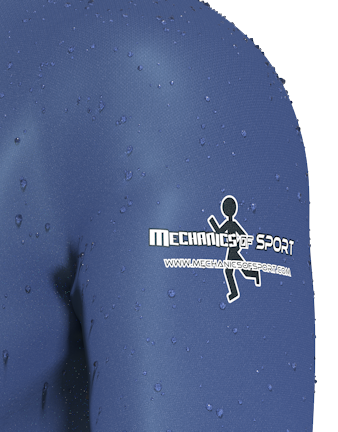
Ski clothing is very functional, with every layer playing a role in keeping you warm, dry and comfortable. It is important to remember that although skiing is a lot of fun, you can be in the middle of nowhere, in sub zero temperatures, and in bad weather conditions. So having the right kind of clothing can make a big difference to your comfort and enjoyment.
A general set of ski clothes includes:
- A Ski Jacket
- Ski Pants / Salopettes / Ski Trousers
- Gloves
- A Helmet or Hat
- Goggles or Sunglasses
- A Moisture Wicking Base Layer
- Ski Socks
You might also want to consider wearing or taking with you:
A scarf / neck warmer, thermal mid layers, undergloves, suntan lotion, and lip balm.
Ski Jackets and Pants
Ski jackets and pants are made from a functional fabric, that helps keep you warm and dry on the mountain. There are many types of fabric available and it is good to match your clothing to the types of skiing you will be doing and the kind of person you are.
Functional Fabrics
The fabrics ski jackets and pants are made from normally have 3 or 4 layers.
- A durable outer fabric layer coated with a durable water repellent (DWR). This layer is normally made of nylon or polyester and provides the durability of the garment. The coating repels water droplets so that they roll off the fabric, making it difficult for water, snow and dirt to penetrate the outer fabric.
- A waterproof / breathable membrane (such as GORE-TEX), which lies under the outer fabric layer. This membrane layer is normally made from ePTFE (expanded Polytetrafluoroethylene) or PU (Polyurethane) and normally determines how waterproof, and breathable the fabric is. The membrane is made of a very fine structure with extremely small holes. The holes are too small for water droplets to pass through, but large enough for water vapour molecules to pass through. This stops water and snow from outside the jacket getting through to the inside, but lets your perspiration out.
- An insulation layer, although this is optional and not included in many fabrics. The insulation layer is the main barrier stopping heat from conducting through the fabric. Insulation in jackets is normally synthetic, but can also be made from down.
- The lining on the inside of the fabric. The lining holds everything else in, and protects the other layers from the inside.
These layers together make a durable, waterproof, breathable, insulated fabric which is very functional for skiing and snowboarding.
Layers of a Waterproof Breathable Fabric
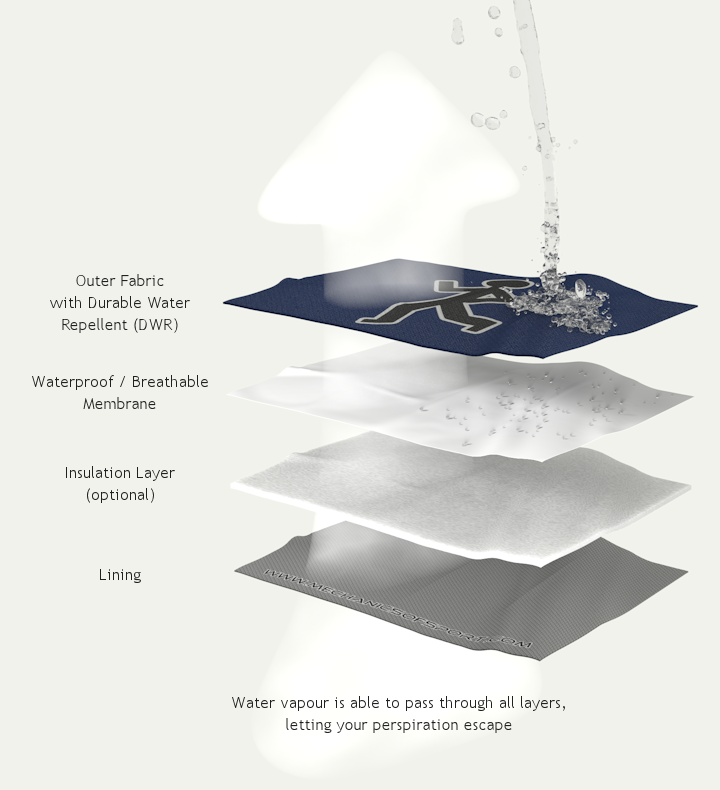
Ski jackets and pants are your outside layers and serve as the barrier between you and the outside world, because of this there are a few properties you should pay attention to, which can also vary a lot.
Waterproof
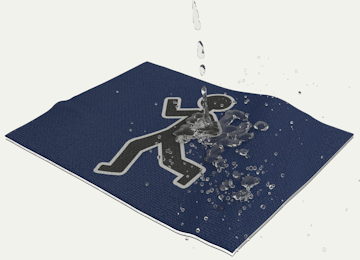
Being waterproof is very important for ski clothing, as if you get wet you will become uncomfortable and get cold very easily. Ski clothing can come in many levels of waterproofness, making different clothing more suitable in different conditions. The waterproof rating is normally stated in mm, which is a measure of the pressure at which water will start to pass through the fabric. For a fabric rated at 10,000mm, you should be able to put a tube over the fabric and fill the tube so that the water is 10,000mm deep before the fabric starts to let the water through. Obviously the higher this number is the more waterproof the fabric should be. Although these values are fairly reliable, there is no industry standard way of obtaining these values, so they cannot be used for an exact comparison.
| Waterproof Rating | Resistance | Suitable For |
| 0 - 5,000 mm | Low | Very light rain, dry snow |
| 5,000 - 10,000 mm | Medium | Light rain, average snow |
| 10,000 - 15,000 mm | High | Moderate rain, average snow |
| 15,000 - 20,000 mm | High | Heavy rain, wet snow |
| 20,000 mm + | Very High | Heavy rain, wet snow, strong winds, long periods |
Lower ratings will keep water out perfectly well in mild conditions, but in wet conditions, strong winds, sitting down, and falling can put a lot more pressure on the waterproof layer, and over longer durations can test even the most waterproof of fabrics.
For a jacket to be waterproof, all the seams also need to be sealed or taped, so that water cannot enter the jacket through the stitching.
Breathable
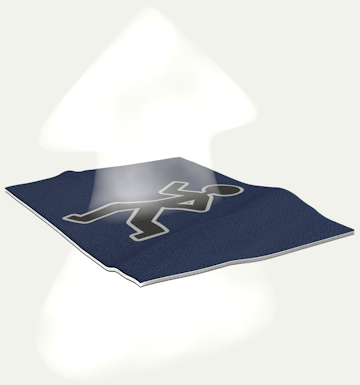
As said in the waterproof section, if you get wet you will get cold and uncomfortable very easily, so it is important not to get wet from the inside as well. Breathable membranes let water vapour through, but not water droplets, meaning your sweat can escape, without snow or water getting in. Having breathable clothing can increase comfort hugely, as you don't want to have a damp layer next to your skin all day. It is also important with a breathable jacket that you wear the correct layers underneath, as the breathability will only work properly if your base and mid layers let moisture pass through them. The breathability rating of a fabric is normally given in grams, indicating how many grams of water vapour can pass through a square metre of the fabric over a 24 hour period. Therefore a higher value means more breathable, although methods of obtaining these values vary even more than for waterproof ratings, so they need to be taken with a pinch of salt.
How breathable you want a fabric to be, is best matched to what you will be doing. As a fabric breathes it also lets some heat out, which can make you cold unless you are using a lot of energy and working hard, so it is often best to have a fabric that is only as breathable as you need it to be.
| Breathability Rating | Breathability | Suitable For |
| 0 - 5,000 g | Low | Activities with low perspiration |
| 5,000 - 10,000 g | Medium | General skiing and snowboarding |
| 10,000 - 15,000 g | High | High energy skiing and snowboarding, and short hikes |
| 20,000 g + | Very High | Ski touring and long hikes |
Durability
The outer layer of most fabrics that ski jackets and pants are made from are fairly durable and should not get damaged so easily, but if you are looking for a very lightweight or breathable fabric, you might well find the materials used are less durable.
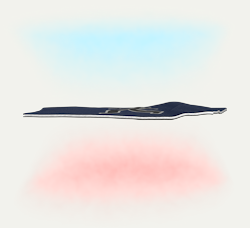
Insulation
The insulation in jackets or pants needs to be matched with how you intend to use them, and the type of person you are. If you are someone who gets cold easily, and only skis in the middle of winter, a jacket with a good amount of insulation might be a good choice. However if you get warm easily, or you intend to use the jacket in spring time, you might well be better off with a jacket with very little or no insulation, and instead use extra base layers and mid layers for insulation when you need it.
Base Layers
Base layers are the layer you wear next to your skin. They are very important, as when they are used properly they will keep you warm, comfortable and dry throughout the day. Base layers should be made from a moisture wicking material that takes moisture away from your skin, so that it can evaporate more easily. They are generally made from synthetic fabrics like Polypropylene, or from Merino wool.
You should not wear cotton under your jacket, as cotton soaks up water rather than repelling it. A cotton base or mid layer will stop your perspiration from evaporating through your jacket anywhere near as effectively.
Mid Layers
Mid layers go between your base layer and your jacket, and are used to keep you warmer. It is often better to use mid layers to insulate yourself, rather than having thicker insulation in your jacket, as mid layers can be added and removed to regulate your temperature.
If you want to dress up warm for the slopes, lots of thin layers will be warmer than 1 thick layer, because pockets of air get trapped between each layer further increasing the insulating effect. This also makes it more comfortable as you don't have to be as padded out to keep warm, and should you get too warm you can always remove just one thin layer to try to find the right balance.
Types of Insulation
There are a few different types of insulation that can be used in mid layers, as well as in jackets and pants. The main types being, down, synthetic, and fleece.
Down
Down is made from extremely fine feathers, normally from geese or ducks. It is the best insulator under optimal conditions but stops working as well if it gets wet, and is slow drying. Down insulation is good for very cold, dry days, where you are unlikely to be too warm or sweat too much.
Synthetic
Synthetic insulation is normally made from thin polyester fibres, which provide a similar amount of insulation to down. Synthetics are generally heavier and less durable than down, but are a lot more effective when wet and much quicker drying, making them good for wetter days, or days when you are likely to sweat.
Fleece
The insulation properties of fleece are not as high as down and synthetic insulation, but it is cheaper and highly breathable. For the average skier and snowboarder it is a very effective mid layer to keep you warmer on the slopes, while letting your jacket breath efficiently.
Outerwear Features
Ski jackets and pants can have several other features that you might want to look out for.
Vents
Vents are zips, normally under the arms, or along the side of the legs, which when opened create a gap in the jacket or pants, covered by a mesh. Vents are an extremely effective way of letting fresh air into a jacket or pants to regulate your temperature. They also mean that a jacket can be made of a less breathable material which conserves heat better when it's cold, yet allow the jacket to instantly become much more breathable when you need to stay cool. Note that vents work best while you are moving with some decent airflow, so for activities where you move more slowly like ski touring, they will not make up for a less breathable fabric.
Snow Skirt
A snow skirt is a band on the inside of a jacket which can be wrapped tightly around your lower waist. It can be used to stop snow from going up your jacket so easily if you fall, and it can also help keep warm air inside your jacket on those colder days.
Hood
Hoods aren't used so often while skiing any more, but most jackets still have them, either built in or removable.
Adjustable Hem / Cuffs
Having an adjustable hem and cuffs can help keep the snow and weather out by giving you a closer fit in areas where they are more likely to get in.
Waterproof Zips
Waterproof zips are simply zips that have been made with a seal so that they won't let water through. Many jackets just have a flap that goes across in front of the zip to keep snow and water away from it, but if you really don't want water to be able to get in, a waterproof zip is the best solution.
Windproofing
Some jackets and clothing have a windproof layer rather than a waterproof layer. The windproof layer is often put on the inside of a fleece, and allows perspiration to escape while being very effective at keeping the wind out. Windproof layers will let water through, so are best used in the right conditions and for the right activities.
Choosing Your Clothing
Although you can never be prepared for all conditions that you might come across on the slopes, it is important to match what you take with you, to what you are going to do. If it is a nice sunny warm day, and where you are going, you will be able to come off the mountain easily at any time. Then you can just take clothes that aren't so warm with you, and if the weather changes you know you can head back before you get too cold. If you are going somewhere that will take a long time to get back from, or it is extremely cold, you will need to be more careful with what you wear and take with you. For spring skiing, a softshell jacket with a thin base layer is often enough, as it will keep you relatively cool, but if the weather changes it is still a waterproof and windproof layer that can keep most people warm enough for an hour or so.
Using Dry Clothing
An important thing to note about clothing is to make sure that your clothes dry out overnight after each day skiing. Things like gloves especially can end up quite damp by the end of a day, and it is always a good idea to leave them hanging above a radiator (not on a radiator) overnight. If your clothes are still damp from the day before you will get cold much more quickly than if they were dry.
On to the Protective Clothing section.